Asus A8N-VM CSM: NVIDIA GeForce 6150 Finally Arrives
by Wesley Fink on December 1, 2005 12:04 AM EST- Posted in
- Motherboards
Audio Performance
Since this is the first NVIDIA implementation of HD audio, we tested to see how it compared with HD audio implementations from ATI. For audio testing, we used Rightmark 3D Sound CPU utilization test Version 2.1. This benchmark measures the overhead or CPU utilization required by a codec or hardware audio chip. Since we found that Version 2.1 yields different results from the earlier 1.24, we have only included test results with version 2.1.
It is very important to point out that NVIDIA only provides HD audio for high-end AMD Integrated Graphics solution like this A8N-VM CSM board. There is no current NVIDIA HD option for nForce4 or nForce Dual x16 discrete chipsets for AMD processors. We are happy to see NVIDIA offering HD audio on the GeForce chipsets, and we hope that they will soon offer similar or better solutions for their discrete chipsets.
Ethernet Performance
Asus used the hooks in the 430 Southbridge to provide Gigabit LAN on the A8N-VM. Since this was the first time we had seen the Marvell 88E1111 PHY, we decided to test the performance of the on-board Ethernet.
The Windows 2000 Driver Development Kit (DDK) includes a useful LAN testing utility called NTttcp. We used the NTttcp tool to test Ethernet throughput and the CPU utilization of the various Ethernet Controllers used on the AMD motherboards.
We set up one machine as the server; in this case, an Intel box with an Intel CSA Gigabit LAN connection. Intel CSA has a reputation for providing fast throughput and this seemed a reasonable choice to serve our Gigabit LAN clients. At the server side, we used the following Command Line as suggested by the VIA whitepaper on LAN testing:
Since this is the first NVIDIA implementation of HD audio, we tested to see how it compared with HD audio implementations from ATI. For audio testing, we used Rightmark 3D Sound CPU utilization test Version 2.1. This benchmark measures the overhead or CPU utilization required by a codec or hardware audio chip. Since we found that Version 2.1 yields different results from the earlier 1.24, we have only included test results with version 2.1.
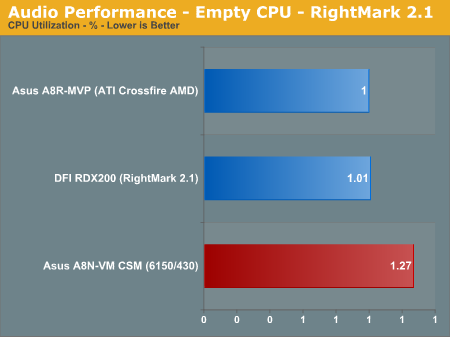
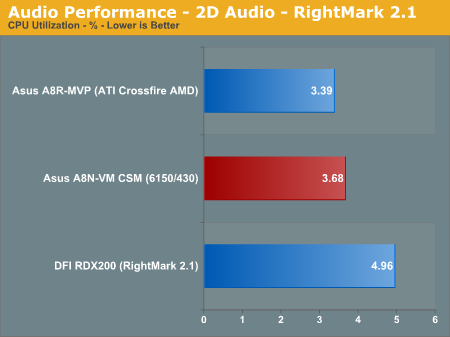
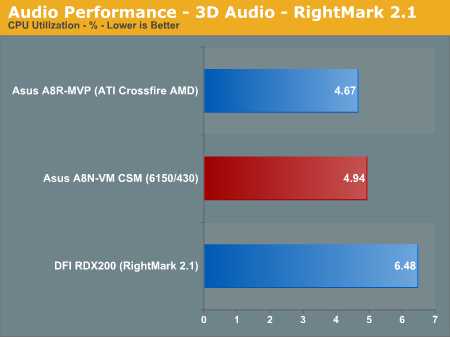
It is very important to point out that NVIDIA only provides HD audio for high-end AMD Integrated Graphics solution like this A8N-VM CSM board. There is no current NVIDIA HD option for nForce4 or nForce Dual x16 discrete chipsets for AMD processors. We are happy to see NVIDIA offering HD audio on the GeForce chipsets, and we hope that they will soon offer similar or better solutions for their discrete chipsets.
Ethernet Performance
Asus used the hooks in the 430 Southbridge to provide Gigabit LAN on the A8N-VM. Since this was the first time we had seen the Marvell 88E1111 PHY, we decided to test the performance of the on-board Ethernet.
The Windows 2000 Driver Development Kit (DDK) includes a useful LAN testing utility called NTttcp. We used the NTttcp tool to test Ethernet throughput and the CPU utilization of the various Ethernet Controllers used on the AMD motherboards.
We set up one machine as the server; in this case, an Intel box with an Intel CSA Gigabit LAN connection. Intel CSA has a reputation for providing fast throughput and this seemed a reasonable choice to serve our Gigabit LAN clients. At the server side, we used the following Command Line as suggested by the VIA whitepaper on LAN testing:
Ntttcps -m 4 ,0,‹client IP› -a 4 -l 256000 -n 30000On the client side (the motherboard under test), we used the following Command Line:
Ntttcpr -m 4 ,0,‹server IP› -a 4 -l 256000 -n 30000At the conclusion of the test, we captured the throughput and CPU utilization figures from the client screen.
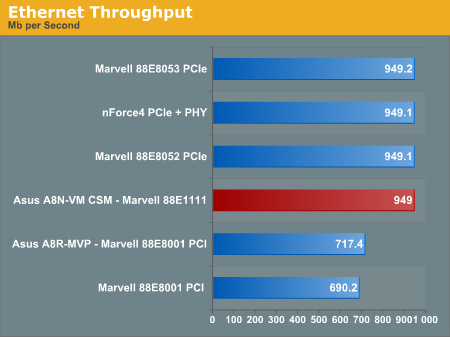
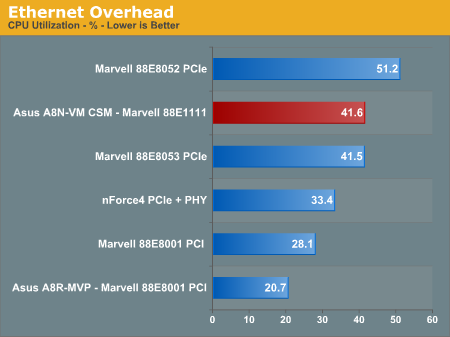










56 Comments
View All Comments
Wesley Fink - Thursday, December 1, 2005 - link
The Asus DOES include HD Audio with the AD1986 codec - the same codec used for HD on the recently reviewed A8R-MVP. However, SPDIF is provided by an optional SPDIF module and TV out is also an optional module. That means you will need to buy optional modules to fully use these features.Donegrim - Thursday, December 1, 2005 - link
or if they are just headers, solder some wires onto the approriate points. Well, you might save some money.TowerShield - Wednesday, November 30, 2005 - link
Doesn't it have HD Audio? Is the on-board sound not real HD?bob661 - Thursday, December 1, 2005 - link
After looking through the manual for the board it appears that you have to buy a seperate S/PDIF (fiber optic) module in order to get the true 5.1 surround audio. Also, in order to get the TV Out (S-video) you have to buy that seperately too. 5.1 is not standard and neither is the TV Out. That sucks a bit. Why not include at least the optical out as standard considering most motherboards have it?LoneWolf15 - Thursday, December 1, 2005 - link
I agree, ASUS made a big mistake in not including a TV-out +SPDIF (preferrably coax and optical) on a single backplate and including it with this mainboard. This looks like an incredible board for an HTPC product --and that one simple mistake takes it from perfect to missing the mark.bob661 - Thursday, December 1, 2005 - link
It DOES have the HD Audio module but you won't be able to get true 5.1 sound without the optical out.